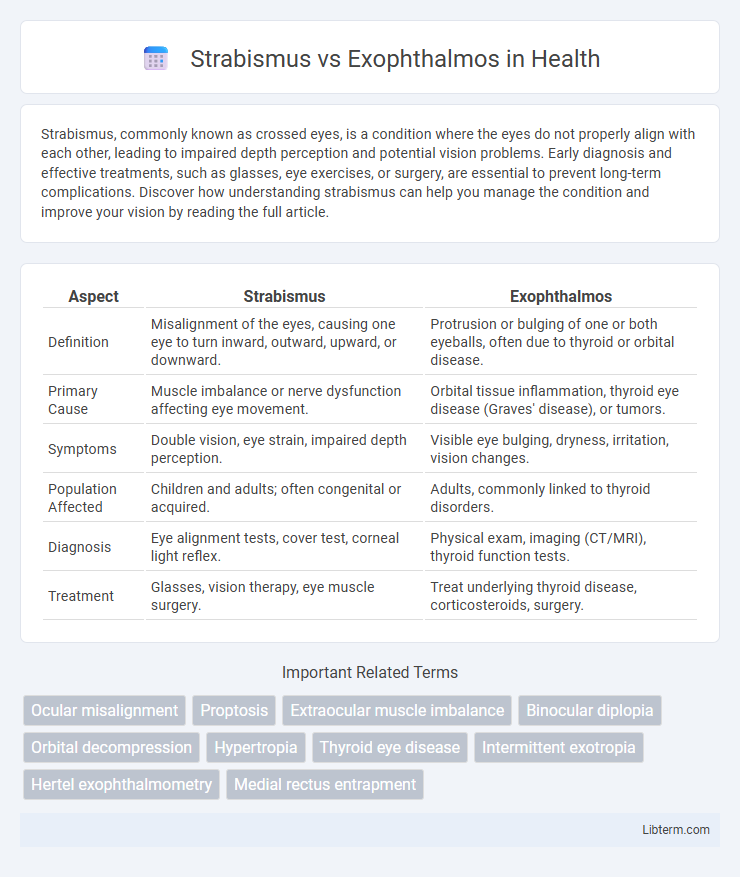Strabismus, commonly known as crossed eyes, is a condition where the eyes do not properly align with each other, leading to impaired depth perception and potential vision problems. Early diagnosis and effective treatments, such as glasses, eye exercises, or surgery, are essential to prevent long-term complications. Discover how understanding strabismus can help you manage the condition and improve your vision by reading the full article.
Table of Comparison
| Aspect | Strabismus | Exophthalmos |
|---|---|---|
| Definition | Misalignment of the eyes, causing one eye to turn inward, outward, upward, or downward. | Protrusion or bulging of one or both eyeballs, often due to thyroid or orbital disease. |
| Primary Cause | Muscle imbalance or nerve dysfunction affecting eye movement. | Orbital tissue inflammation, thyroid eye disease (Graves' disease), or tumors. |
| Symptoms | Double vision, eye strain, impaired depth perception. | Visible eye bulging, dryness, irritation, vision changes. |
| Population Affected | Children and adults; often congenital or acquired. | Adults, commonly linked to thyroid disorders. |
| Diagnosis | Eye alignment tests, cover test, corneal light reflex. | Physical exam, imaging (CT/MRI), thyroid function tests. |
| Treatment | Glasses, vision therapy, eye muscle surgery. | Treat underlying thyroid disease, corticosteroids, surgery. |
Introduction to Strabismus and Exophthalmos
Strabismus is a condition characterized by the misalignment of the eyes, where one eye may turn inward, outward, upward, or downward, leading to impaired binocular vision and potential amblyopia if untreated. Exophthalmos, also known as proptosis, involves the abnormal protrusion of one or both eyeballs, commonly caused by thyroid eye disease, orbital tumors, or inflammation. Both disorders significantly affect ocular appearance and function but differ fundamentally in etiology and clinical presentation, requiring distinct diagnostic and therapeutic approaches.
Defining Strabismus: Causes and Symptoms
Strabismus, commonly known as crossed eyes, is a condition in which the eyes do not properly align with each other when looking at an object. Causes include muscle imbalance, nerve injury, or congenital defects, and symptoms often involve double vision, eye strain, or difficulty with depth perception. Unlike exophthalmos, which is characterized by abnormal protrusion of the eyeball usually due to thyroid eye disease, strabismus primarily affects eye alignment and coordination.
Understanding Exophthalmos: Key Features
Exophthalmos, characterized by abnormal protrusion of the eyeball, differs from strabismus, which involves misalignment of the eyes. Key features of exophthalmos include visible bulging of one or both eyes, eyelid retraction, and potential exposure-related complications such as dryness or corneal damage. Common causes include Graves' disease, orbital tumors, and inflammation, which necessitate thorough medical evaluation and imaging for accurate diagnosis and management.
Differentiating Strabismus from Exophthalmos
Strabismus involves misalignment of the eyes due to muscular imbalance, resulting in one eye deviating inward, outward, upward, or downward, while exophthalmos is characterized by abnormal protrusion of one or both eyeballs, often linked to thyroid eye disease. Differentiating strabismus from exophthalmos relies on clinical signs such as the absence of forward eye bulging in strabismus and the presence of globe protrusion and eyelid retraction in exophthalmos. Imaging studies like orbital CT or MRI further aid differentiation by revealing extraocular muscle enlargement in thyroid orbitopathy versus normal orbital anatomy in pure strabismus cases.
Common Causes of Strabismus
Strabismus, commonly caused by neurological disorders, muscle dysfunction, or congenital abnormalities, results in misalignment of the eyes, impairing binocular vision. Exophthalmos, often linked to thyroid eye disease such as Graves' orbitopathy, involves abnormal protrusion of the eyeball without necessarily affecting eye alignment. Understanding the distinct etiology of strabismus, including cranial nerve palsies and refractive errors, aids in differentiating it from exophthalmos during diagnosis.
Underlying Causes of Exophthalmos
Exophthalmos primarily results from inflammatory thyroid eye disease, commonly associated with Graves' orbitopathy, which causes swelling and inflammation of the extraocular muscles and orbital fat. Other underlying causes include orbital tumors, infections, or trauma leading to increased orbital pressure and protrusion of the eyeball. Unlike strabismus, which stems from ocular muscle imbalances or nerve dysfunctions, exophthalmos is characterized by the forward displacement of the eye due to orbital pathology.
Diagnostic Approaches: Strabismus vs Exophthalmos
Strabismus diagnosis primarily involves a comprehensive eye exam including the cover-uncover test, Hirschberg test, and measurement of ocular alignment using prisms to assess misalignment severity. Exophthalmos diagnosis relies on physical examination to measure protrusion of the eyeball using an exophthalmometer, supplemented by imaging techniques such as CT or MRI scans to identify underlying causes like thyroid eye disease or orbital tumors. Both conditions require thorough evaluation to determine etiology and inform appropriate treatment strategies.
Treatment Options for Strabismus
Strabismus treatment options primarily include corrective glasses, prism lenses, vision therapy, and surgical intervention to realign the eye muscles. Early intervention with orthoptic exercises and patching therapy can improve binocular vision and prevent amblyopia. Surgical procedures, such as muscle resection or recession, are often recommended when non-invasive methods fail to restore proper ocular alignment.
Management and Treatment of Exophthalmos
Management of exophthalmos primarily focuses on treating the underlying cause, such as Graves' disease, using antithyroid medications, corticosteroids, or orbital radiotherapy to reduce inflammation and proptosis. Surgical options like orbital decompression are considered in severe cases to alleviate optic nerve compression and improve ocular alignment. Supportive treatments include lubricating eye drops or ointments to prevent exposure keratopathy and prism glasses to address diplopia caused by eye misalignment.
Prognosis and Long-Term Outcomes
Strabismus prognosis varies depending on the underlying cause, with early intervention often leading to better alignment and binocular vision restoration, while delayed treatment may result in permanent amblyopia. Exophthalmos outcomes largely depend on the severity and cause, such as thyroid eye disease, where controlling systemic disease can stabilize or improve eye protrusion, but irreversible optic nerve damage may lead to vision loss. Long-term management of both conditions involves regular monitoring to prevent complications and preserve visual function.
Strabismus Infographic

 libterm.com
libterm.com